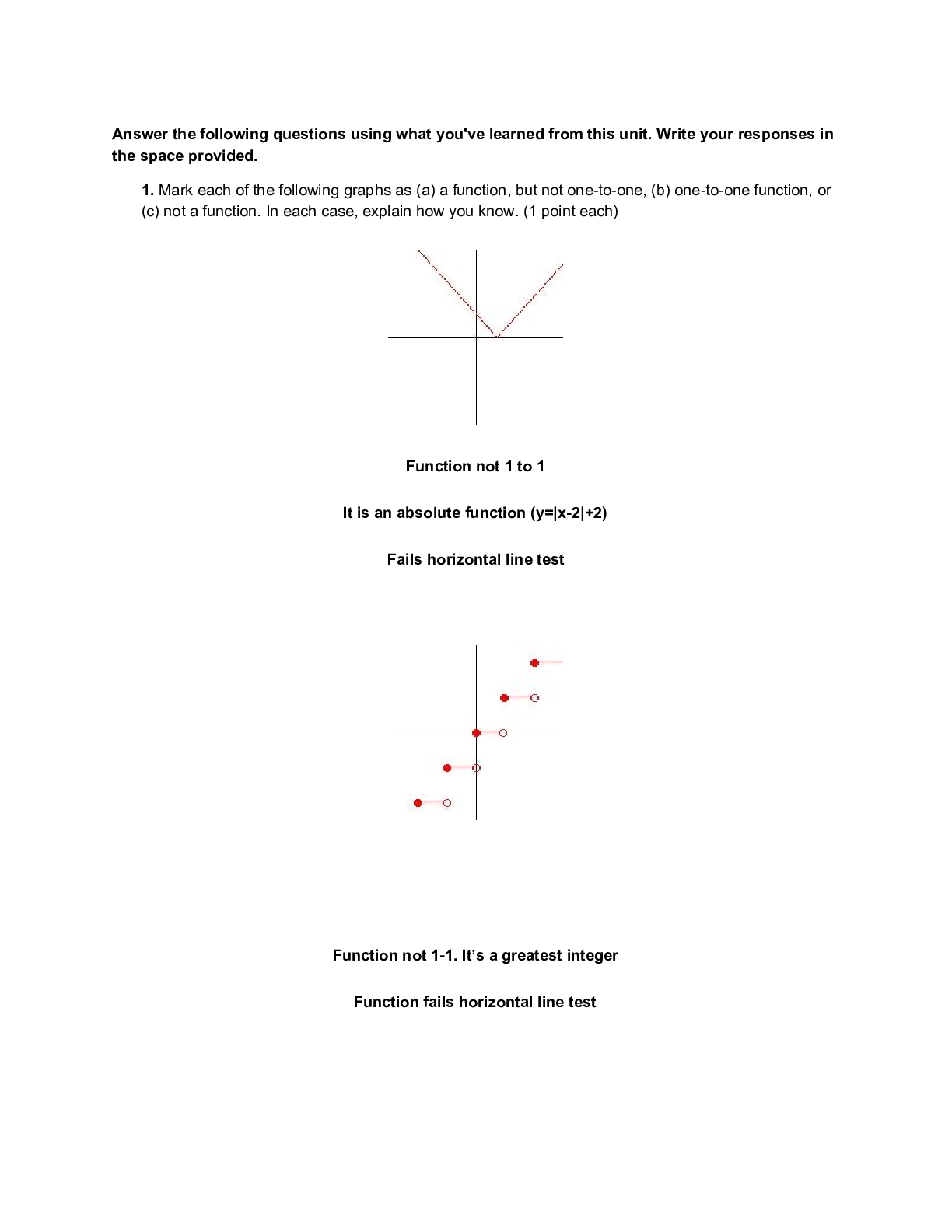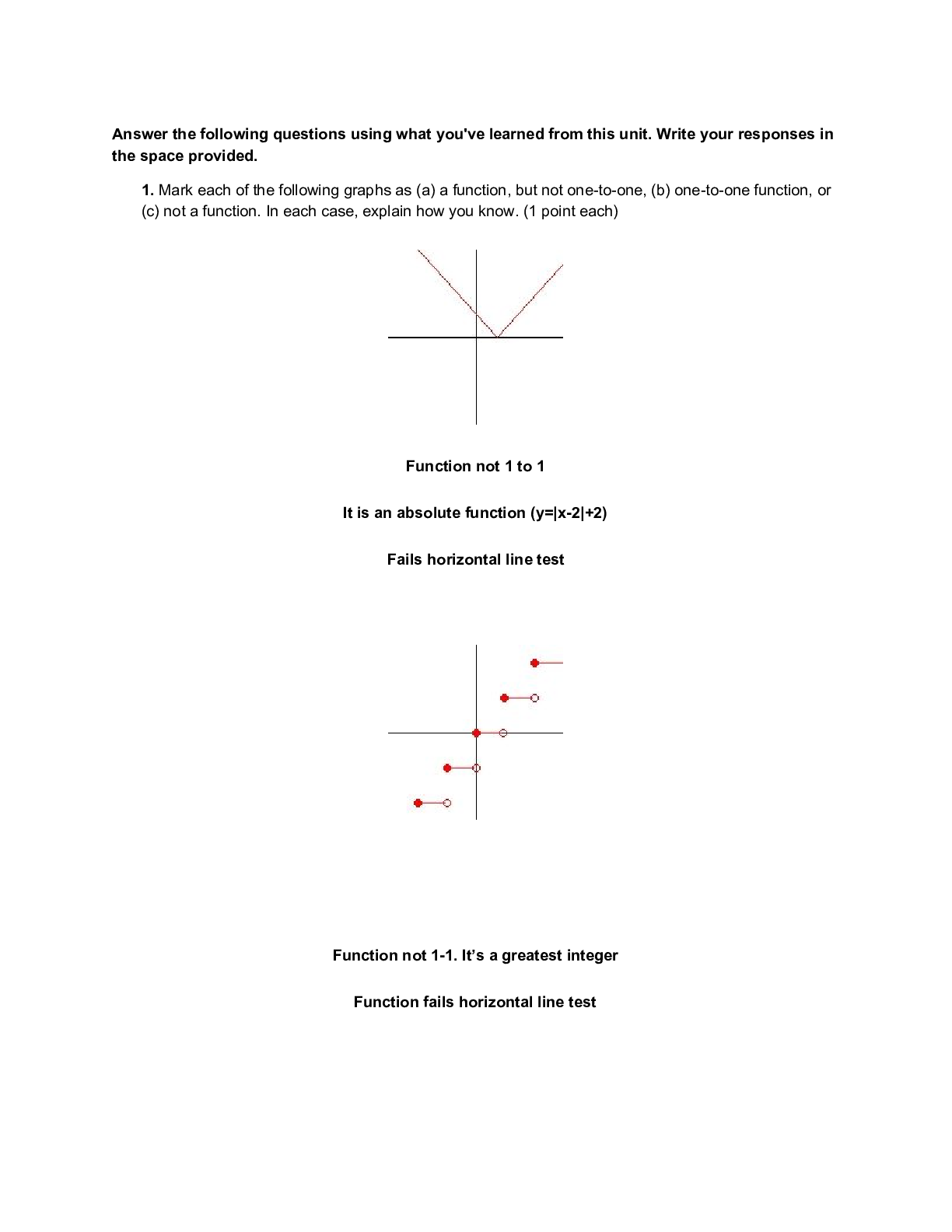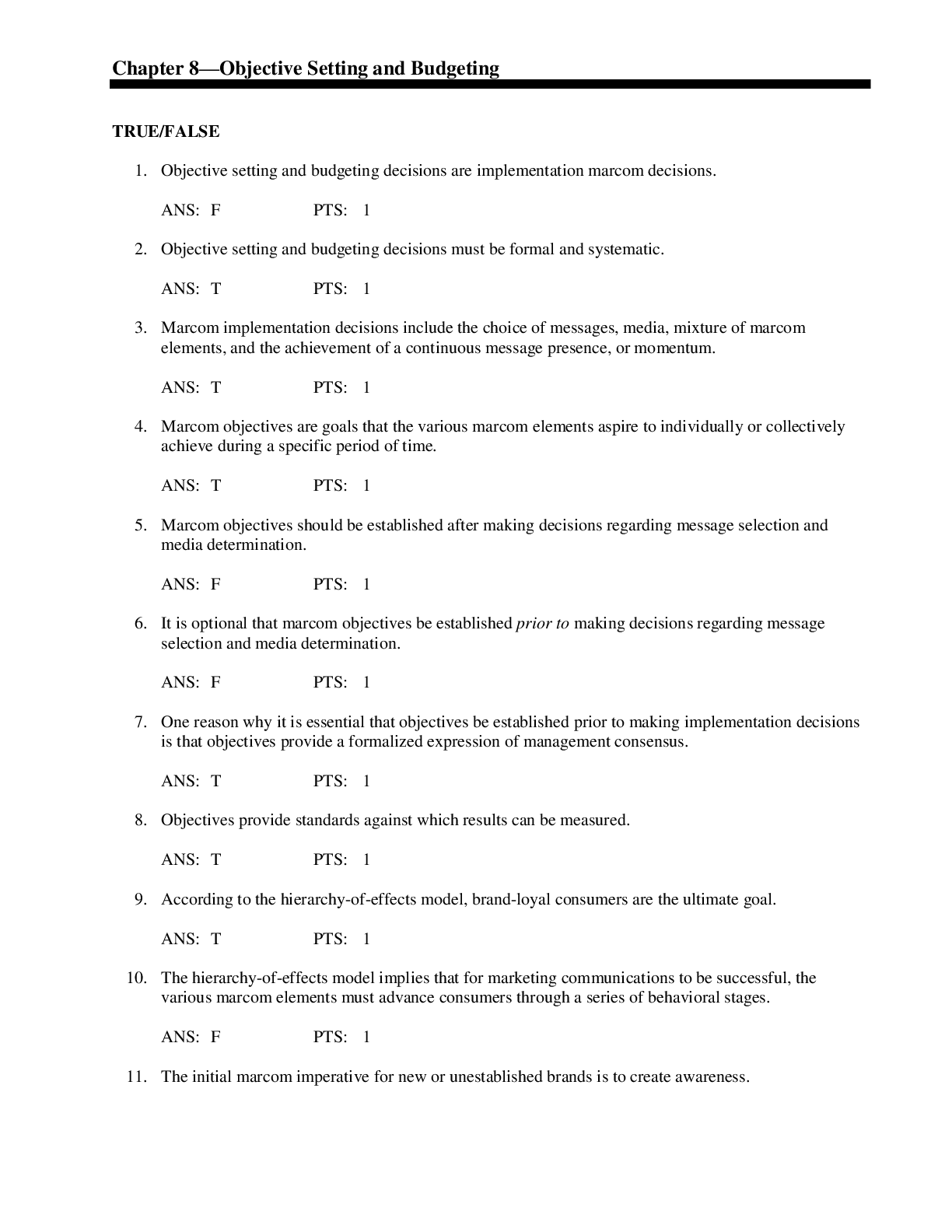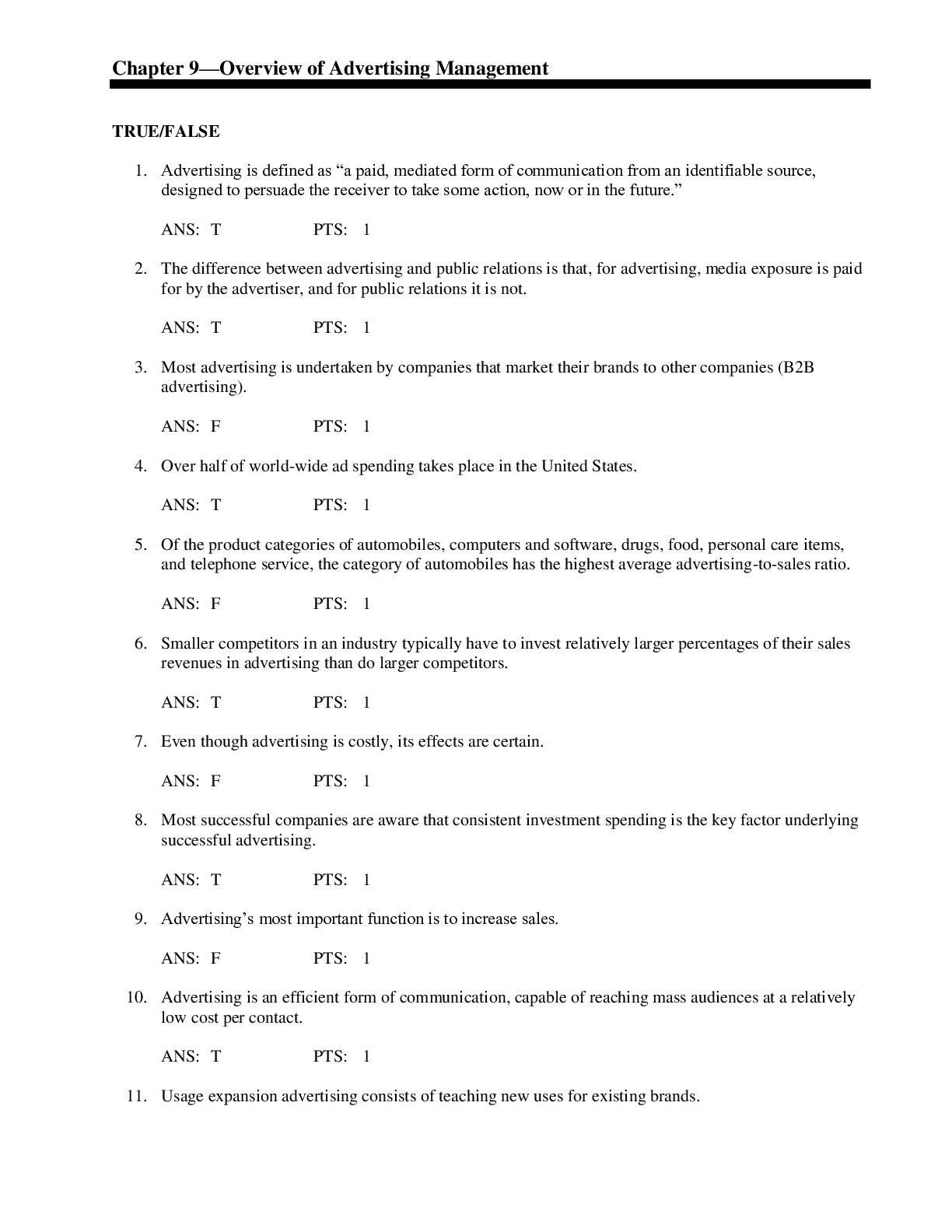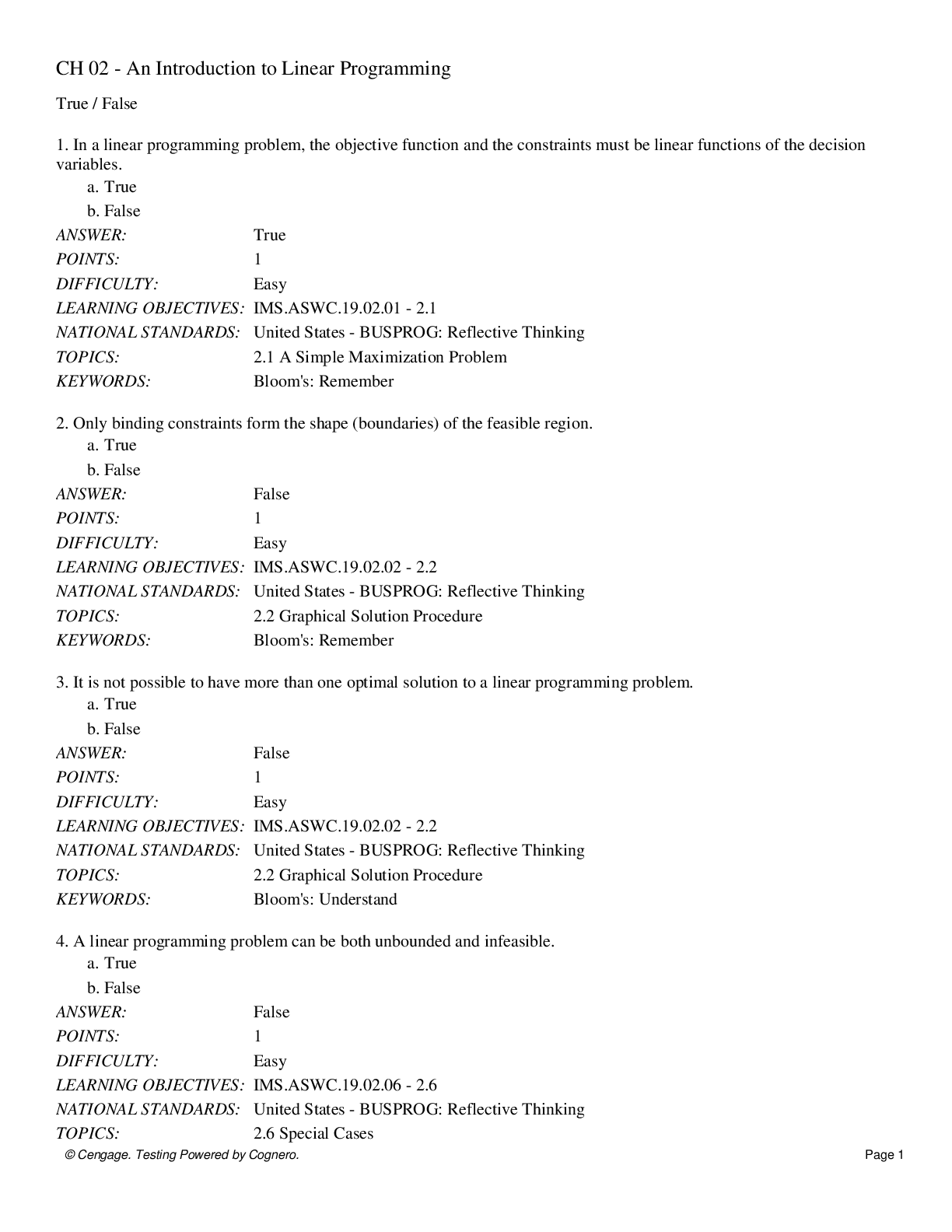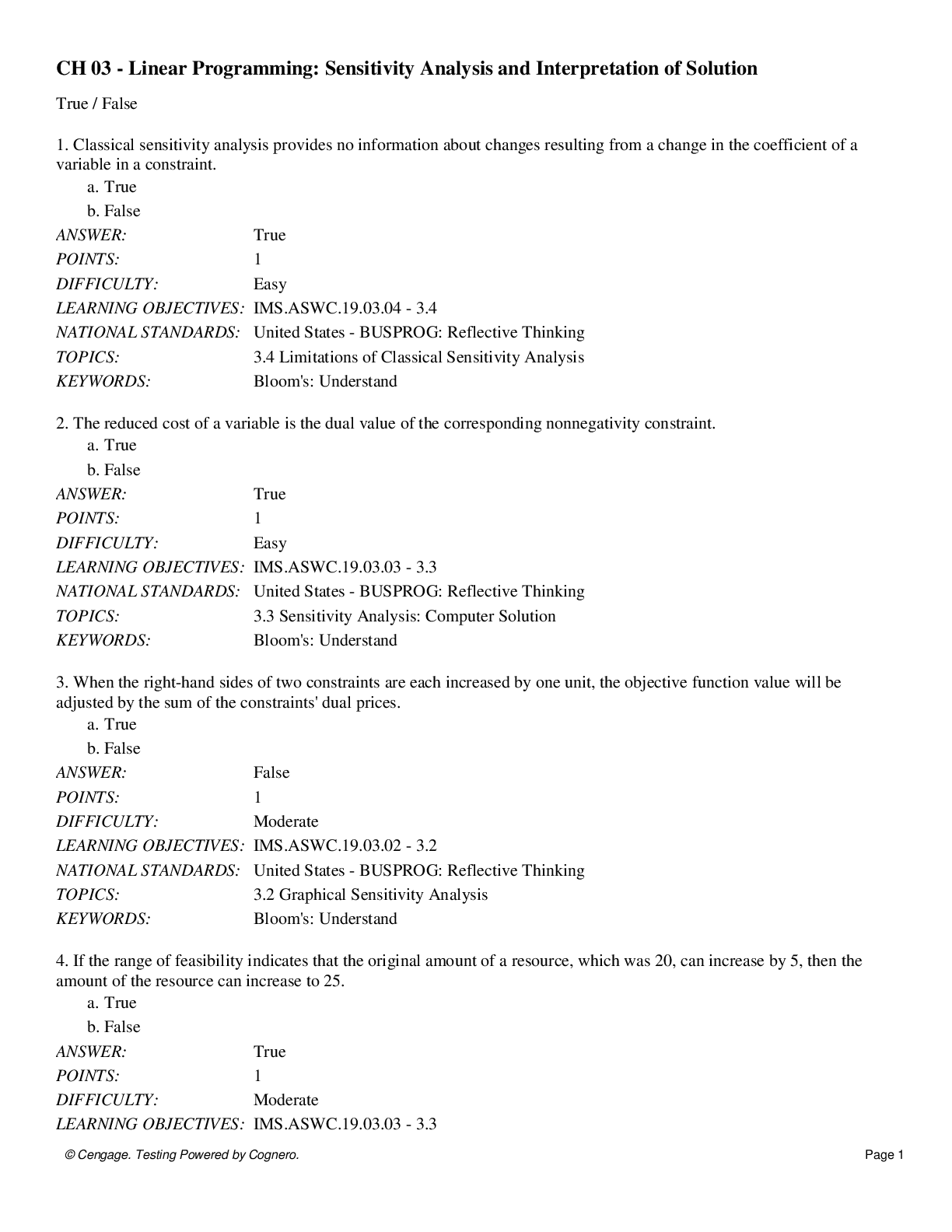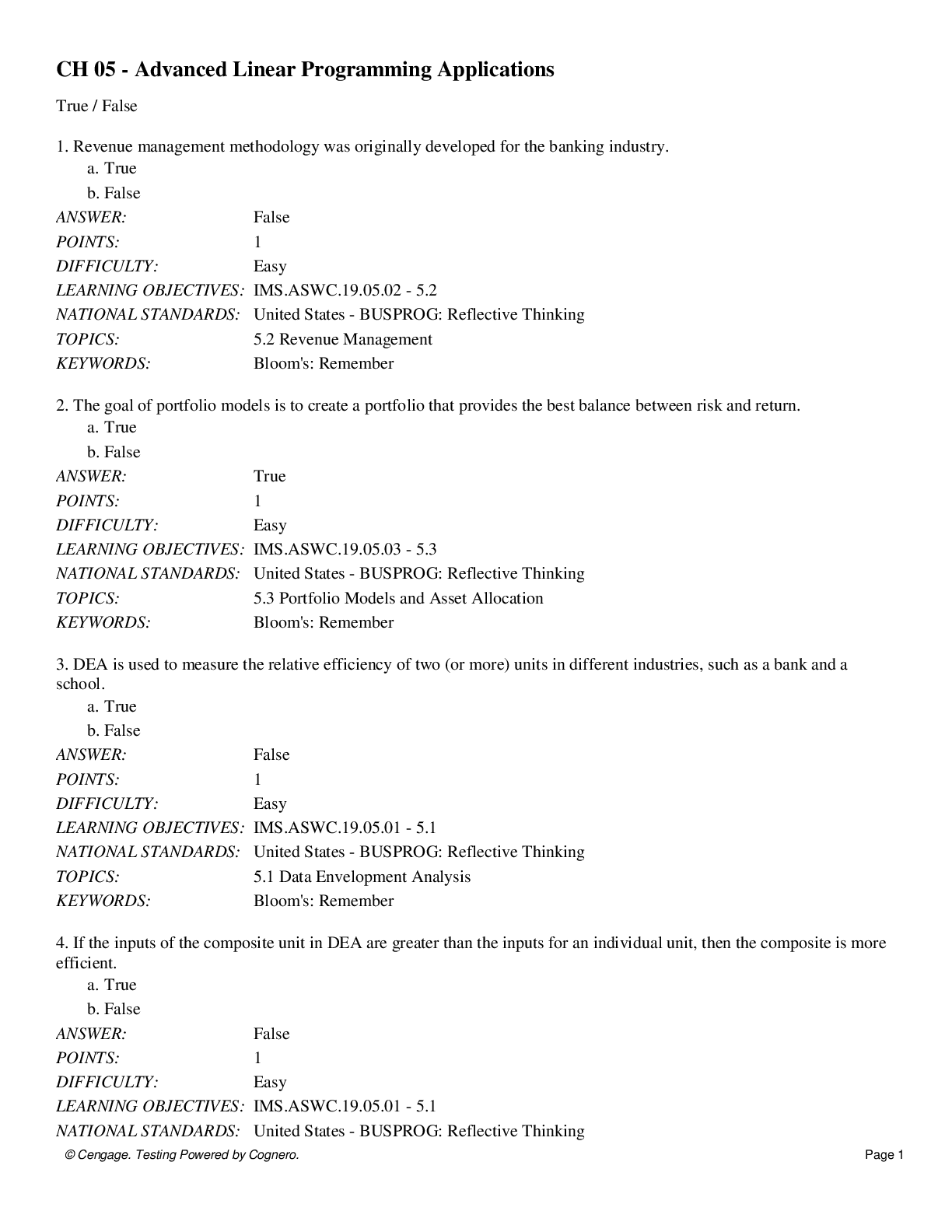*NURSING > QUESTIONS & ANSWERS > NURSING: NEONATE: Questions and Answers With Explanations. Best Review Exam. (All)
NURSING: NEONATE: Questions and Answers With Explanations. Best Review Exam.
Document Content and Description Below
Neonate Study and Review Question and Answers Question 1 A nurse is about to give a full-term neonate his first bath. How should the nurse proceed? Question 2 When teaching parents ... of a neonate the proper position for the neonate's sleep, a nurse stresses the importance of placing the neonate on his back to reduce the risk of: Question 3 The neonate of a client with type 1 diabetes is at high risk for hypoglycemia. An initial sign the nurse should recognize as indicating hypoglycemia in a neonate is: Question 4 How should a nurse assess a neonate's rooting reflex? Question 5 A term neonate's mother is O-negative, and cord studies indicate that the neonate is A-positive. Which finding indicates that the neonate developed hemolytic disease? Question 6 An alarm signals, indicating that a neonate's security identification band requires attention. The nurse responds immediately and finds that the parents removed the identification bands from the neonate. Which action should the nurse take next? Question 7 Which assessment finding would lead a nurse to suspect dehydration in a preterm neonate? Question 8 After teaching the multiparous mother about hemolytic disease of the newborn and Rh sensitization, the nurse determines that the client understands why she was not sensitized during her other pregnancy when she makes which statement? Question 9 A newborn is diagnosed with fetal alcohol syndrome. The nurse is teaching this mother what to expect when she goes home with her baby. The nurse determines the mother needs further instruction when she makes which statement? Question 10 After a lengthy labor, a primigravid client gives birth to a healthy newborn boy with a moderate amount of skull molding. What information would the nurse include when explaining to the parents about this condition? Question 11 The nurse is caring for a primiparous client and her neonate immediately after birth. The neonate was born at 41 weeks' gestation and weighs 9 lb (4,082 g). Assessing for signs and symptoms of which signs and symptoms should be a priority in this neonate? Question 12 The nurse observes a darkish blue pigment on the buttocks and back of a neonate of African descent. Which action is most appropriate? Question 13 The parents of a neonate born with congenital clubfoot express feelings of helplessness and guilt and are exhibiting anxiety about how the neonate will be treated. Which action by the nurse would be most appropriate initially? Question 14 Which action would be most appropriate for a neonate whose hemoglobin is 16 g/dL (160 g/L) immediately after birth? Question 15 When obtaining a blood sample to screen a neonate for phenylketonuria (PKU), the nurse should obtain the sample from the: Question 16 A nurse is demonstrating umbilical cord care to a client who recently gave birth. Which actions should the nurse teach the client to perform? Select all that apply. Question 17 A woman who has recently immigrated from Africa and given birth to a term neonate a short time ago requests that a “special bracelet” be placed on the baby’s wrist. The nurse should: Question 19 Assessment of a term neonate at 2 hours after birth reveals a heart rate of less than 100 bpm, periods of apnea approximately 25 to 30 seconds in length, and mild cyanosis around the mouth. The nurse notifies the health care provider (HCP) based on the interpretation that these findings may lead to which condition? Question 20 When performing an initial assessment of a postterm male neonate weighing 4,000 g (8 lb, 13 oz) who was admitted to the observation nursery after a vaginal birth with low forceps, the nurse detects Ortolani’s sign. Which action should the nurse take next? Question 1 Sick and preterm neonates who experience continuity of nursing care directly benefit from: Question 2 Which action is the best precaution against transmission of infection? Question 3 A neonate born 18 hours ago with myelomeningocele over the lumbosacral region is scheduled for corrective surgery. Preoperatively, what is the most important nursing goal? Question 4 The nurse is teaching the mother of a newborn to develop her baby's sensory system. To further improve the infant's most developed sense, the nurse should instruct the mother to: Question 5 After completing discharge instructions for a primiparous client who is bottle-feeding her term neonate, the nurse determines that the mother understands the instructions when the mother says that she should contact the pediatrician if the neonate exhibits which sign or symptom? Question 6 A full-term neonate is admitted to the normal newborn nursery. When lifting the baby out of the crib the nurse notes the baby’s arms move sideways with the palms up and the thumbs flexed. What should the nurse do next? Question 7 Which finding would the nurse most expect to find in a neonate born at 28 weeks’ gestation who is diagnosed with intraventricular hemorrhage (IVH)? Question 8 A mother is visiting her neonate in the neonatal intensive care unit. Her baby is fussy and the mother wants to know what to do. In order to quiet a sick neonate, what can the nurse teach the mother to do? Question 9 A multiparous client gives birth to dizygotic twins at 37 weeks' gestation. The twin neonates require additional hospitalization after the client is discharged. What is the most appropriate goal to include in the plan of care for the parents while the twins are hospitalized? Question 10 The nurse should be especially alert for what problem when caring for a term neonate, who weighed 10 lb (4,500 g) at birth, 1 hour after a vaginal birth? Question 11 When developing a teaching plan for the mother of an infant about introducing solid foods into the diet, which measure should the nurse expect to include in the plan to help prevent obesity? Question 12 During the first feeding, the nurse observes that the neonate becomes cyanotic after gagging on mucus. What should the nurse do first? Question 13 While caring for a just born female term neonate, the nurse observes that the neonate’s clitoris is enlarged and there is some fusion of the posterior labia majora. The nurse should notify the health care provider because these findings are associated with which problem? Question 14 A neonate is experiencing respiratory distress and is using a neonatal oxygen mask. An unlicensed assistive personnel has positioned the oxygen mask as shown. The nurse is assessing the neonate and determines that the mask: Question 15 During an assessment of a neonate born at 33 weeks' gestation, a nurse finds and reports a heart murmur. An echocardiogram reveals patent ductus arteriosis, for which the neonate received indomethacin. An expected outcome after the administration of indomethacin to a neonate with patent ductus arteriosis is: Question 16 An infant 5 hours old and weighing 7 lb (3,180 g) has a prescription for gentamicin sulfate 13 mg every 36 hours. The pharmacy sends gentamicin 20 mg/2 mL. How many milliliters should the nurse administer? Record your answer using one decimal place. Question 17 Parents of a newborn with Down syndrome are tearful when they tell the nurse that the diagnosis was a surprise to them. Which statement by the parents indicates that they have some understanding of Down syndrome? Question 18 A newborn baby has developed physiologic jaundice. The parents are concerned about the appearance of the newborn and ask the nurse about their concerns. Which of the following would be the most appropriate response by the nurse? Question 19 A client is exclusively breastfeeding her 1-week-old infant and is concerned about her baby taking enough milk per day. The client tells the nurse that the infant has six wet diapers per day. Which of the following responses by the nurse is most appropriate? Question 20 While changing her newborn’s diaper, a mother states: “there is some bleeding from the vagina.” Which of the following is the nurse's appropriate response? Question 1 A neonate weighing 3 lb, 5 oz (1,503 g) is born at 32 weeks' gestation. During an assessment 12 hours after birth, a nurse notices these signs and symptoms: hyperactivity, a persistent shrill cry, frequent yawning and sneezing, and jitteriness. These symptoms indicate: Question 2 Which complication is common in neonates who receive prolonged mechanical ventilation at birth? Question 3 A nurse assesses a 1-day-old neonate. Which finding indicates respiratory distress? Question 4 A client with a history of drug abuse gives birth to a low-birth-weight neonate who is experiencing drug withdrawal. Which intervention is helpful for this neonate? Question 5 A nurse is assessing a 1-hour-old neonate in the special care nursery. Which assessment finding indicates a metabolic response to cold stress? Question 6 A nurse is caring for a neonate with congenital clubfoot. The child has a cast to correct the defect. Before discharge, what should the nurse tell the parents? Question 7 While the nurse is caring for a neonate at 32 weeks' gestation in an isolette with continuous oxygen administration, the neonate's mother asks why the neonate's oxygen is humidified. The nurse should tell the mother? Question 8 While caring for a neonate born at 32 weeks’ gestation, which finding would most suggest the infant is developing necrotizing enterocolitis (NEC)? Question 9 While caring for a male neonate diagnosed with gastroschisis, the nurse observes that the parents seem hesitant to touch the neonate because of his appearance. The nurse determines that the parents are most likely experiencing which stage of grief? Question 10 The nurse is caring for a neonate at 38 weeks’ gestation when the nurse observes marked peristaltic waves on the neonate’s abdomen. After this observation, the neonate exhibits projectile vomiting. The nurse notifies the health care provider (HCP) because these signs are indicative of which problem? Question 11 The mother of a newborn is concerned about the number of persons with heart disease in her family. She asks the nurse when she should start her baby on a low-fat, low-cholesterol diet to lower the risk of heart disease. The nurse should tell her to start diet modifications: Question 12 While preparing to provide neonatal care instructions to a primiparous client who gave birth to a term neonate 24 hours ago, what should the nurse include in the client's teaching plan? Question 13 The client who is breastfeeding asks the nurse if she should supplement breastfeeding with formula feeding. The nurse bases the response on which principle? Question 14 The nurse is preparing to administer erythromycin ophthalmic ointment to a neonate soon after birth. The nurse should explain to the parents that this medication, in addition to preventing blindness caused by gonococcal organisms, also prevents neonatal blindness caused by which organism? Question 15 While performing a complete assessment of a term neonate, which finding would alert the nurse to notify the health care provider (HCP)? Question 16 Two hours ago, a neonate at 38 weeks’ gestation and weighing 3,175 g (7 lb) was born to a primiparous client who tested positive for beta-hemolytic Streptococcus. Which finding would alert the nurse to notify the health care provider (HCP)? Question 17 During the initial assessment, the nurse notes that the neonate’s hands and feet appear blue while the neonate’s torso appears pale pink. What should the nurse do next? Question 18 A viable female neonate was delivered ten minutes ago and is in stable condition under a radiant warmer. To prevent infant heat loss by convection, the nurse should: Question 20 A mother who is breastfeeding and has known food sensitivities is asking the nurse what foods she should avoid in her diet. Which foods should the nurse advise the client to avoid? Select all that apply. Question 1 A client received magnesuim sulfate during labor. Which condition should the nurse anticipate as a potenial problem in the neonate? Question 2 When caring for the neonate of a mother with gestational diabetes, which finding is most indicative of a hypoglycemic episode? Question 3 After circumcision with a Plastibell, the nurse should instruct the neonate's mother to cleanse the circumcision site with which agent? Question 4 While assessing a male neonate whose mother desires him to be circumcised, the nurse observes that the neonate’s urinary meatus appears to be located on the ventral surface of the penis. The health care provider (HCP) is notified because the nurse suspects which complication? Question 5 A nurse is reviewing a client's maternal prenatal record and notes that the mother used narcotics during her pregnancy. A primary nursing intervention when caring for a drug-exposed neonate is to: Question 6 After teaching the mother about the neonate’s positive Babinski’s reflex, the nurse determines that the mother understands the instructions when she says that a positive Babinski’s reflex indicates which condition? Question 7 One hour after receiving nalbuphine for pain during labor, a primigravida gives birth to a full-term neonate with symptoms of respiratory depression. The nurse anticipates that the neonate will require the administration of which drug? Question 8 The nurse is caring for a 2-day-old neonate in the post-anesthesia care unit 30 minutes after surgical correction for the cardiac defect, transposition of the great vessels. Which finding would alert the nurse to notify the health care provider (HCP)? Question 9 A neonate born at 38 weeks’ gestation is admitted to the neonatal nursery for observation. The neonate’s mother, who is positive for human immunodeficiency virus (HIV) infection, has received no prenatal care. The mother asks the nurse if her neonate is positive for HIV. The nurse can tell the mother which information? Question 1 A nurse has been teaching a new mother how to feed her infant who was born with a cleft lip and palate. Which action by the mother indicates that the teaching has been successful? Question 2 A nurse is preparing a neonate for circumcision. Which behavior is the best example of nursing advocacy? Question 3 After the birth of her first neonate, a mother asks the nurse about the reddened areas at the nape of the neonate's neck. How should the nurse respond? Question 4 After birth, a direct Coombs test is performed on the umbilical cord blood of a neonate with Rh-positive blood born to a mother with Rh-negative blood. The nurse explains to the client that this test is done to detect which information? Question 5 After teaching the parents of a neonate born with a cleft lip and cleft palate about appropriate feeding techniques, the nurse determines that the mother needs further instruction when the mother says makes which statement? Question 1 A client's gestational diabetes is poorly controlled throughout her pregnancy. She goes into labor at 38 weeks and gives birth. Which priority intervention should be included in the care plan for the neonate during his first 24 hours? Question 2 During the admission assessment of a female neonate, a nurse notes a large lump on the neonate's head. Concerned about making the correct assessment, the nurse differentiates between caput succedaneum and a cephalohematoma based on the knowledge that: Question 3 As part of the respiratory assessment, a nurse observes the neonate's nares for patency and mucus. The information obtained from this assessment is important because: Question 4 A registered nurse on the neonatal unit appropriately uses the chain of command when she: Question 5 A primigravid client in early labor tells the nurse that she was exposed to rubella at about 14 weeks' gestation. After birth, the nurse should assess the neonate for which complication? Question 1 A nurse caring for a preterm neonate knows that positioning can benefit high-risk neonates. Which position is appropriate for a preterm neonate? Question 2 A neonate born several hours ago shows signs of a tracheoesophageal fistula (TEF). During the initial assessment, what does the nurse expect to find? Question 3 After a vaginal birth, a preterm neonate is to receive oxygen via mask. While administering the oxygen, the nurse would place the neonate in which position? Question 4 The nurse recognizes that teaching about the need for an exchange transfusion in a neonate with erythroblastosis fetalis has been effective if the parents describe the purpose of the transfusion is: Question 5 When preparing to obtain a neonatal screening test for phenylketonuria (PKU), the neonate must have received what to ensure reliable results? [Show More]
Last updated: 1 year ago
Preview 1 out of 28 pages
Instant download
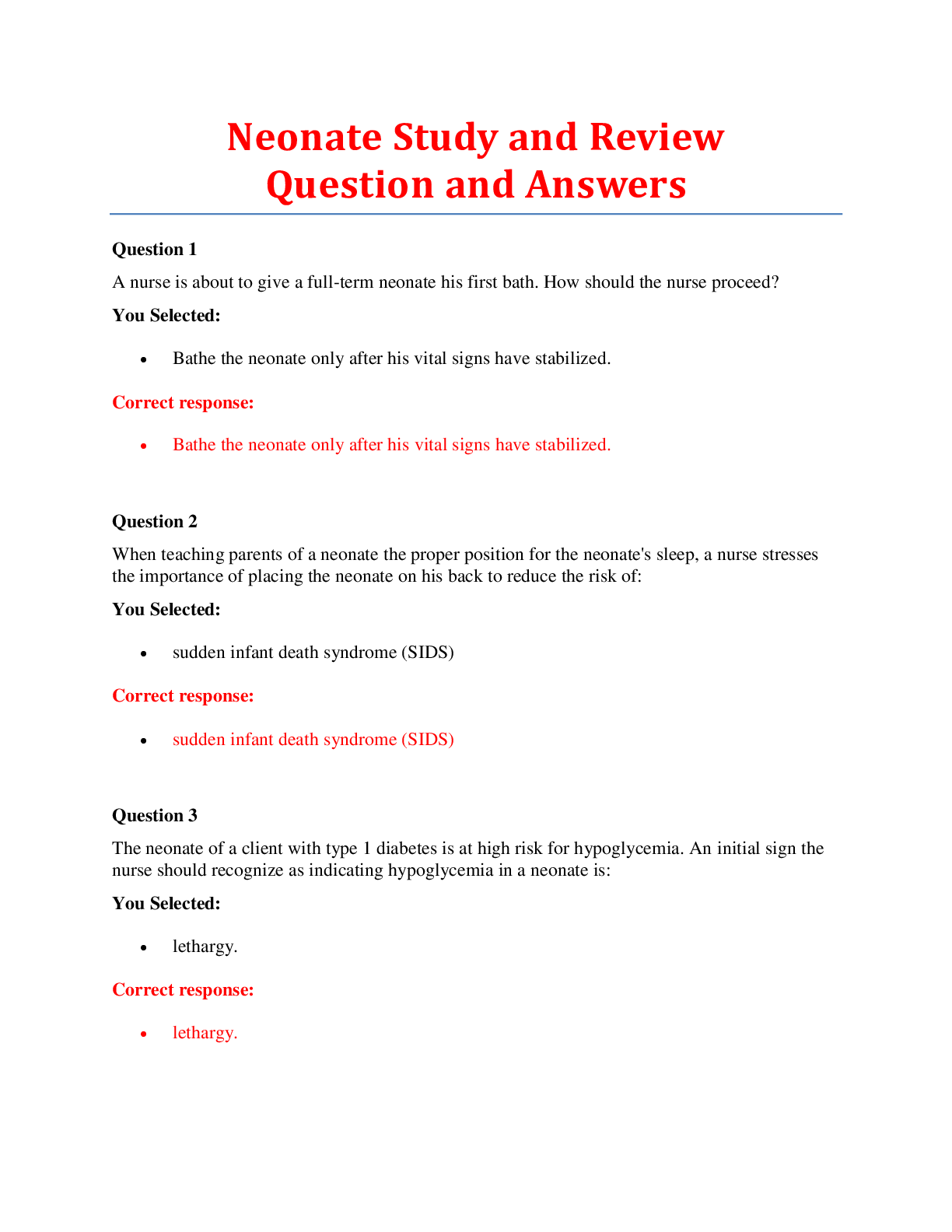
Buy this document to get the full access instantly
Instant Download Access after purchase
Add to cartInstant download
Reviews( 0 )
Document information
Connected school, study & course
About the document
Uploaded On
Aug 02, 2020
Number of pages
28
Written in
Additional information
This document has been written for:
Uploaded
Aug 02, 2020
Downloads
0
Views
116

